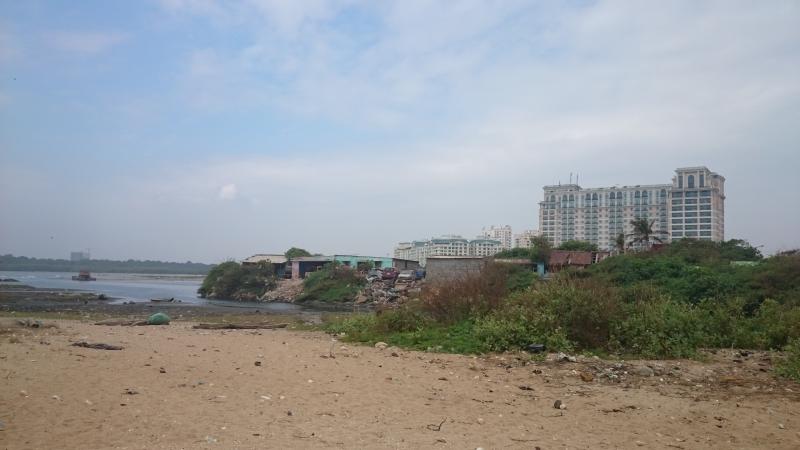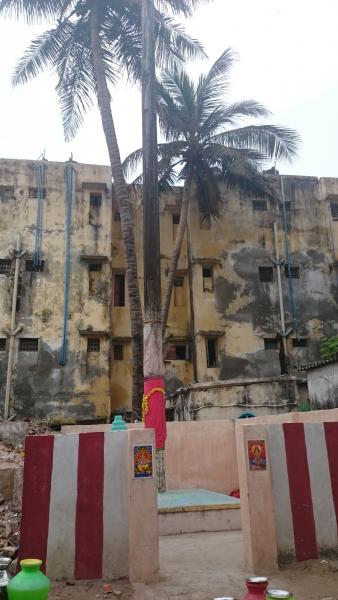It was on a Saturday Morning that I ventured on a walk, along with a group of volunteers, through the fishing communities of Foreshore Estate and Srinivasapuram. The aim was to learn about the way land was being taken away from these communities in the name of development and environmental protection, and the absence of detailed land records places them in a particularly precarious position.
What we noticed through our first glance around the locality was cheerful children who would wave at us on their way to school and busy fisher folk going about their daily chores on the shore. But as we progressed on our walk along with Saravanan Kasi, a fisherman and activist, we understood the underlying reality of land disputes that have resulted in vacant spaces, which have remained unutilised for several years despite the displacement of people. Some of these coastal lands whose ownership lies with not just one but several government bodies were earlier earmarked for a high rise building project. Moreover, the TNHB had attempted to acquire the land by the beach on which there were buildings in exchange for nearby land that was inland. It had also evicted 1000 families and demolished buildings to make way for high and middle income group houses. The Corporation of Chennai had also proposed to build an elevated expressway along the beach on the basis of a highly controversial report. The proposal was dropped because of the protests from fisherfolk and other residents of the city but these spaces have also remained empty close to 10 years now.
As we walked on into the community and towards the beach we discussed about the fisher folk community that stretches from Ennore to Oda kuppam. In the course of our interaction, we came to know that a once popular Fisheries Department’s semi practical training course on fishing methods (which assured government placement opportunities)had been discontinued which had lead to the disappointment of many.
We witnessed the Adyar estuary/ creek –the exact spot at which the Adyar River joins the Bay of Bengal and also understood the raw facts of the prevalent ecological damage. The villagers are alleged to be the main polluters but mainly the discharge of untreated sewage from high-rise buildings and industries along its course that have caused this pollution. There were piles of garbage at the estuary, and a JCB machines was filling up patches of water with sand. We also visited an Olive Ridley hatchery run by the Students Sea Turtle Conservation Network (SSTCN) on the shore and interact with the guardian of the nest who told us about the conservation efforts during this nesting season.
Image 1: Mangroves disappearing among the shifting sands and garbage
We walked north on the Foreshore Estate Promenade till we reached the Lighthouse. The road had been widened and the Corporation of Chennai was building a storm water drain on the side of the road running beside the tenements. This was a continued violation of the CRZ Rules but who is bothered with them! Many houses had been demolished and several others had been marked for demolishing, all because they had been deemed encroachers. It was interesting that the fish stalls operated by the fishing community living in the tenements on the Promenade were all seen to be encroachments as well. One corner of the stretch had been earlier marked for a multi-level car park but no progress had been made yet or the project had been shelved. So the fish stalls and homes were encroachments but not the proposed car park.
We were almost at the end of our walk, weaving through shops and residential complexes of Srinivasapuram when we found the amusing site of an old Dutch Flag Post, now decorated and worshiped by the local community!
Image 2: Dutch flag post in Srinivasapuram
Through all this Sarvanan told us about his efforts to map Urur and Olcott kuppam, a fishing hamlet a little south of Srinivasapuram. This is because the official records do not adequately record fishing villages and the ways in which the villagers use the beach at different times of the day and in different seasons. It was a one-of its kind experience, which was eye opening and thought provoking in so many ways.


Add new comment